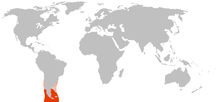Magellanic penguin: Difference between revisions
Christian75 (talk | contribs) m Reverted edits by 212.219.203.27 (talk) to last revision by Jan1nad (HG) |
|||
| Line 31: | Line 31: | ||
== Diet == |
== Diet == |
||
Magellanic Penguins feed in the water |
Magellanic Penguins feed in the water preying on [[cuttlefish]], [[sardine]], [[squid]], [[krill]], and other [[crustacean]]s. Since they ingest water with their prey, a [[supraorbital gland|salt-excreting gland]] has evolved to filter out. |
||
==Breeding== |
==Breeding== |
||
Revision as of 19:05, 17 January 2011
| Magellanic Penguin | |
|---|---|

| |
| near Punta Arena, Chile | |
| Scientific classification | |
| Kingdom: | |
| Phylum: | |
| Class: | |
| Order: | |
| Family: | |
| Genus: | |
| Species: | S. magellanicus
|
| Binomial name | |
| Spheniscus magellanicus (Forster, 1781)
| |

| |
| Red area shows range | |
The Magellanic Penguin, Spheniscus magellanicus, is a South American penguin, breeding in coastal Argentina, Chile and the Falkland Islands, with some migrating to Brazil. It is the most numerous of the Spheniscus penguins. Its nearest relatives are the African Penguin, the Humboldt Penguin and the Galápagos Penguin. They are native to the Strait of Magellan in the cool climate of southern Chile, hence the name's origin[1].
Description


Magellanic Penguins are medium-sized penguins which grow to be 61–76 cm (24–30 in) tall and weigh between 2.7 kg and 6.5 kg (5.9-14.3 lbs)[2][3]. The males are larger than the females and the weight of both drops while the parents nurture their young.
Adults have black backs and white stomachs. There are two black bands between the head and the breast, with the lower band shaped in an inverted horseshoe. The head is black with a broad white border that runs from behind the eye, around the black ear-coverts and chin, and joins at the throat. Chicks and younger penguins have grey-blue backs, with a more faded grey-blue color on their chest. Magellanic Penguins can live up to 25 years in the wild, but as much as 30 years in captivity.
Young birds usually have a blotched pattern on their feet, with this 'blotching' fading as they age. By the time these birds reach about ten years of age, their feet usually become all black.
Like other species of penguins, the Magellanic Penguin has very rigid wings used to "fly" or cruise under water.
Diet
Magellanic Penguins feed in the water preying on cuttlefish, sardine, squid, krill, and other crustaceans. Since they ingest water with their prey, a salt-excreting gland has evolved to filter out.
Breeding

Magellanic Penguins travel in large flocks when hunting for food. In the breeding season, these birds gather in large nesting colonies at the coasts of Argentina, southern Chile, and the Falkland Islands, which have a density of 20 nests per 100 square meters. One of the largest of these colonies is located at Punta Tombo.[4] Nests are built under bushes or in burrows. Two eggs are laid. Incubation lasts 39–42 days, a task which the parents share in 10-15 day shifts. The chicks are cared for by both parents for 29 days and are fed every 2–3 days. Normally both are raised through adulthood, though occasionally only one chick is raised.
Magellanic Penguins mate with the same partner year after year. The male reclaims his burrow from the previous year and waits to reconnect with his female partner. The females are able to recognize their mates through their call alone.
Status in the wild

Millions of these penguins still live on the coasts of Argentina and Chile, but the species is classified as "Threatened species," primarily due to the vulnerability of large breeding colonies to oil spills, which kill 20,000 adults and 22,000 juveniles every year off the coast of Argentina. To help the fight against the oil spills, Zoo representatives from all over the world come and adopt the hatchlings, and breed them there. The decline of fish populations is also responsible, as well as predators such as sea lions and giant petrels, which prey on the chicks
Climate change has displaced fish populations, so Magellanic penguins must swim an extra 25 miles (40 km) further from the nest for fish. While the penguins are swimming an extra 50 miles (80.4 km), their mates are sitting on a nest and starving. A colony being tracked by University of Washington professor P. Dee Boersma, about 1,000 miles (1,609 km) south of Buenos Aires has fallen by more than 20 percent in the past 22 years, leaving 200,000 breeding pairs. Some younger penguins are now moving their breeding colonies north to be closer to fish, but, in some cases, this is putting them on private, unprotected lands.
It is the case that at present 12 out of 17 penguin species are experiencing rapid population declines.
References
- Template:IUCN2006 Database entry includes a brief justification of why this species is near threatened
- Planet Ark. 16 Feb 09. ( http://planetark.org/wen/51620 )
External links
- Puntatombo.com
- Video - Magellanic Penguin chicks at the San Francisco Zoo
- Video - March of the Penguin chicks at the San Francisco Zoo
- Magellanic penguins from the International Penguin Conservation Web Site
- Penguin World: Magellanic penguin
- www.pinguins.info: information about all species of penguins
- Adopt a Magellanic penguin
- A confused Magellanic penguin strays 5000km off course
- Roscoe, R. "Magellanic Penguin". Photo Volcaniaca. Retrieved 13 April 2008.

